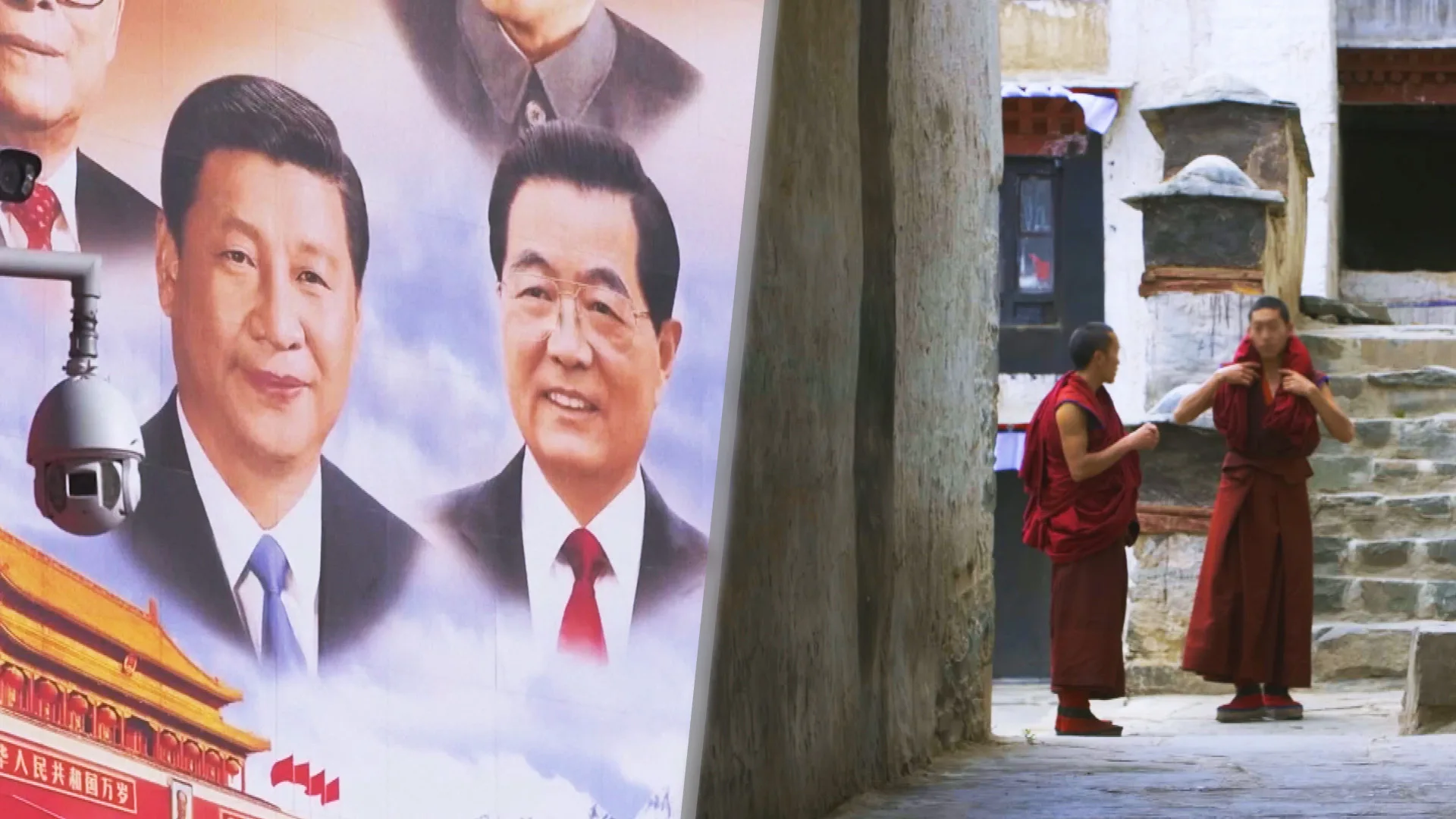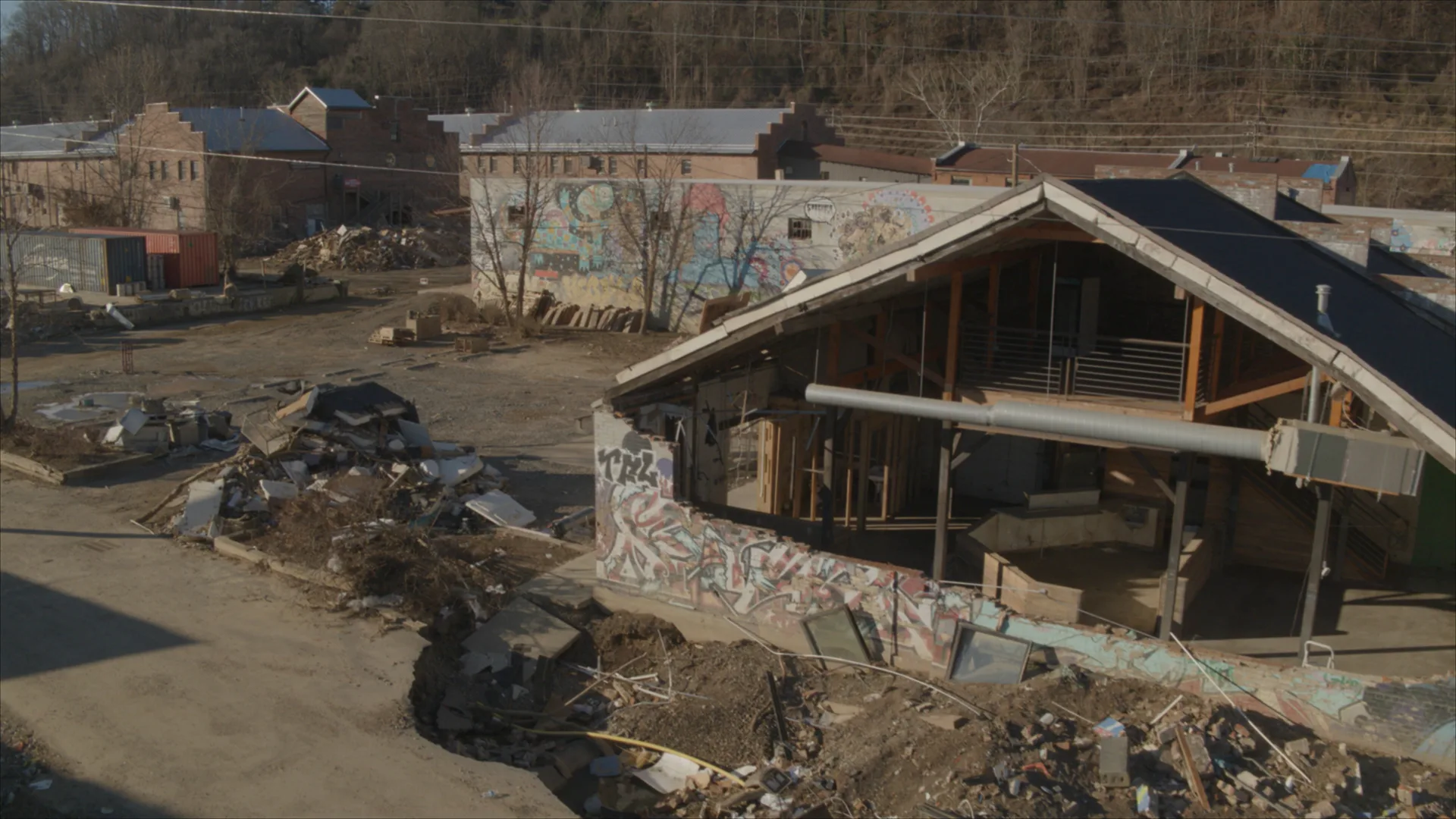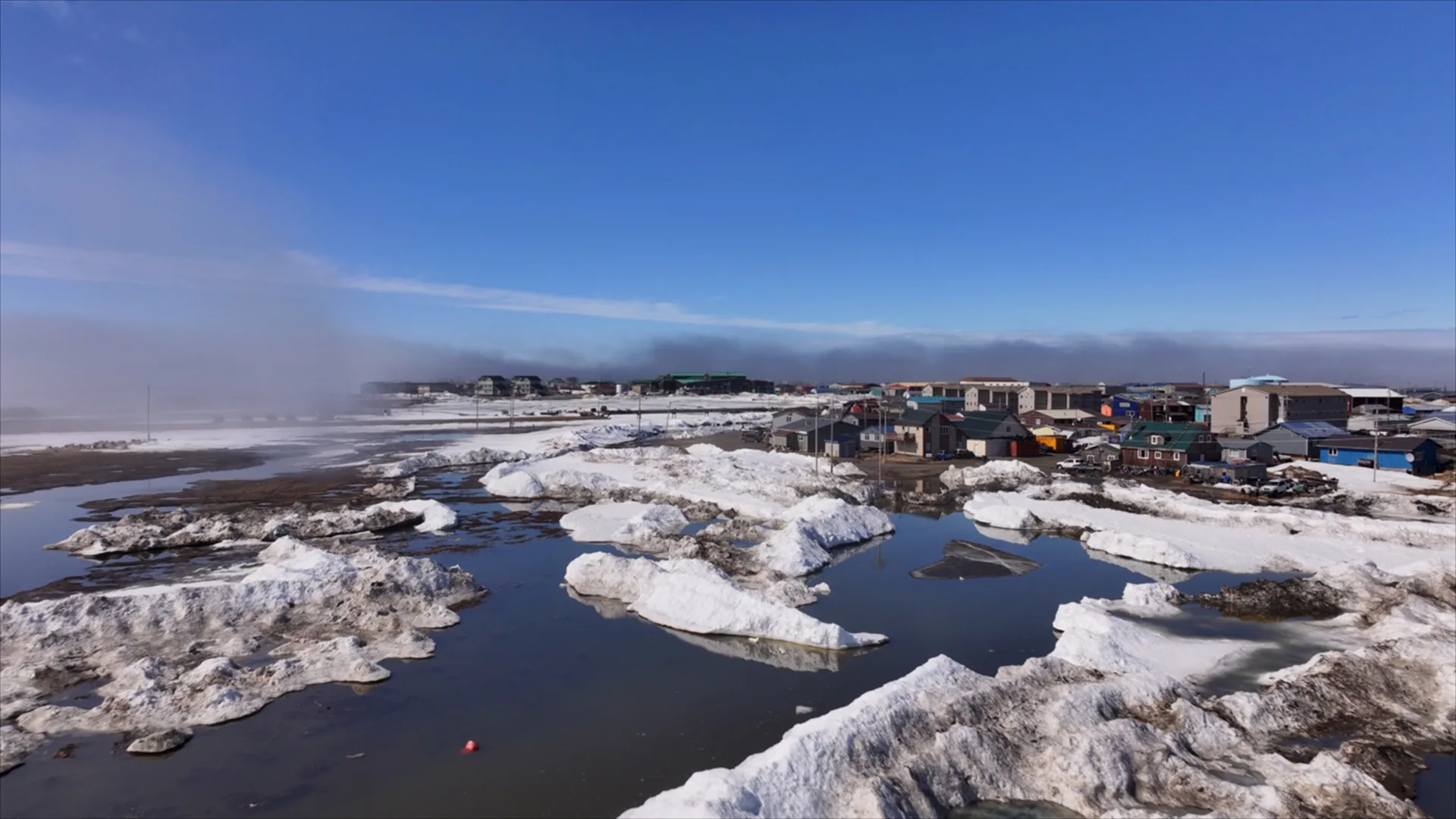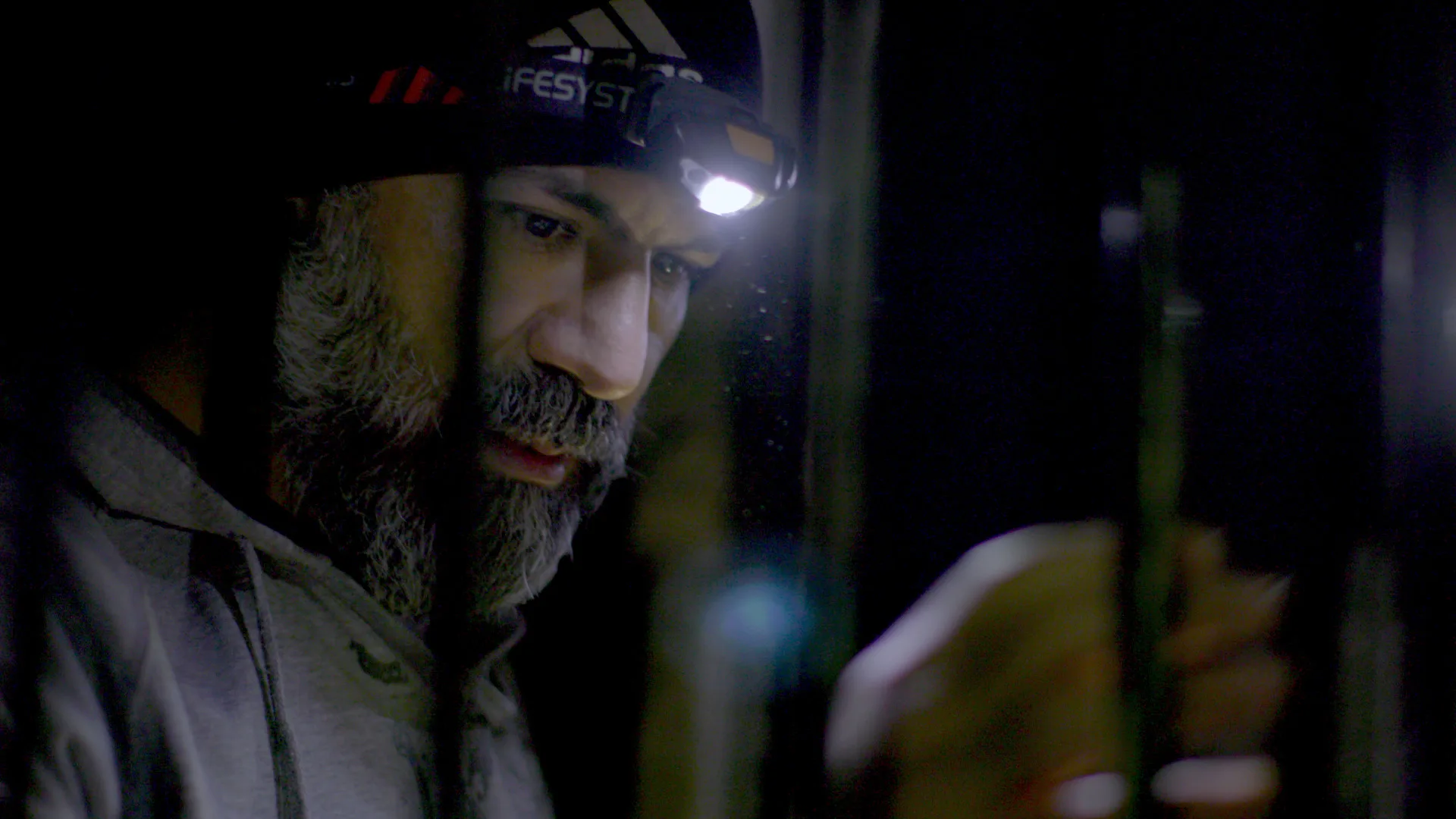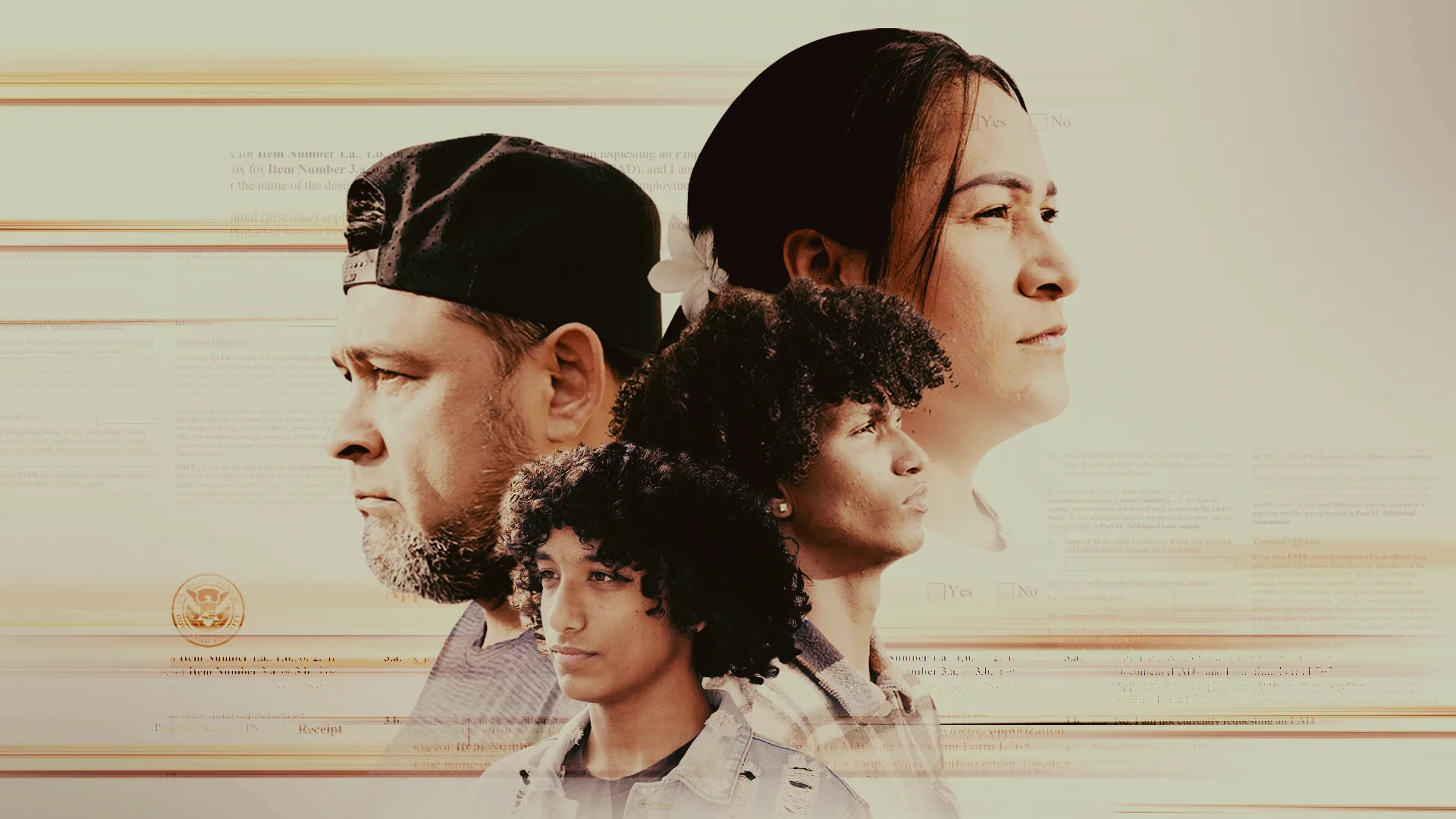America’s Dangerous Trucks
June 13, 2023
54m
FRONTLINE and ProPublica investigate deadly truck accidents and the fight over measures that could save thousands of lives
America’s Dangerous Trucks
June 13, 2023
54m
Share
Deadly traffic accidents involving large trucks have surged over the past decade. FRONTLINE and ProPublica examine one gruesome kind of truck accident — underride crashes — and why they keep happening.
Trucking industry representatives and the government’s lead agency on traffic safety have said that their top priority is safety. Drawing on more than a year of reporting — including leaked documents and interviews with former government insiders, trucking industry representatives, and families of underride crash victims — the documentary reveals how, for decades, federal regulators proposed new rules to try to prevent underride crashes. Over and over, pushback from trucking industry lobbyists won the day, leaving drivers of smaller vehicles vulnerable.
Directed by
Produced by
Correspondent
Transcript
Credits
Journalistic Standards
Support provided by:
Learn More
Most Watched
The FRONTLINE Newsletter
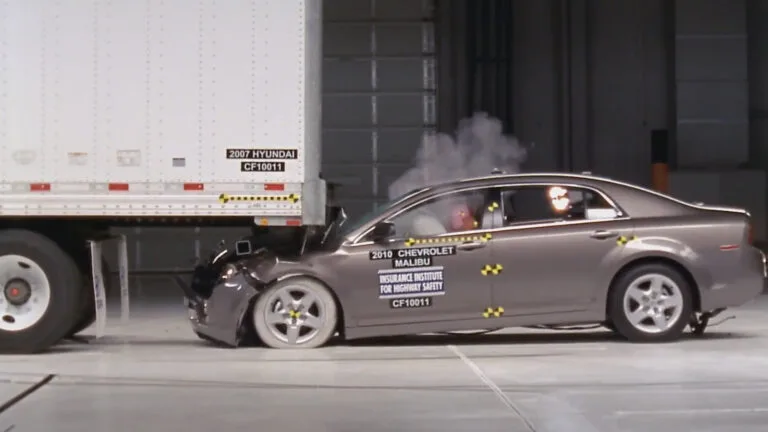
Trapped Under Trucks

What Is An Underride Crash And Why Is It So Dangerous?

She Lost Two Daughters in a Deadly Truck Crash a Decade Ago and Has Advocated For Stronger Regulations Since
Related Stories
Watch 2023’s 10 Most-Streamed New FRONTLINE Documentaries
How Recent State Laws Are Making It Harder to Sue Trucking Companies After Crashes
‘Dangerous Trucks’ on America’s Roads
DOT Researchers Suggested a Way to Make Big Trucks Safer. After Meeting With Lobbyists, Agency Officials Rejected the Idea.
What Is An Underride Crash And Why Is It So Dangerous?
She Lost Two Daughters in a Deadly Truck Crash a Decade Ago and Has Advocated For Stronger Regulations Since
Related Stories
Watch 2023’s 10 Most-Streamed New FRONTLINE Documentaries
How Recent State Laws Are Making It Harder to Sue Trucking Companies After Crashes
‘Dangerous Trucks’ on America’s Roads
DOT Researchers Suggested a Way to Make Big Trucks Safer. After Meeting With Lobbyists, Agency Officials Rejected the Idea.
What Is An Underride Crash And Why Is It So Dangerous?
She Lost Two Daughters in a Deadly Truck Crash a Decade Ago and Has Advocated For Stronger Regulations Since
A.C. THOMPSON:
On any given day, there are millions of big trucks on America’s highways. They tower over everything on the road. A single truck can weigh as much as 20 cars. To get into an accident with one is often fatal. Around 5,000 deaths a year, and 150,000 injuries. And those numbers have been rising. For the past year, I’ve been investigating one gruesome kind of truck crash and why they keep happening.
Albuquerque, NM
A.C. THOMPSON, ProPublica/FRONTLINE:
Can you tell me about this location where we decided to meet?
ERIC HEIN, Riley Hein’s father:
This is a location where we’ve placed a memorial bench for my son Riley. This is a meadow adjacent to the Methodist church in the village where he grew up. A lot of his friends stop by and just sit on the bench and remember him.
A.C. THOMPSON:
Can you tell me about your son?
ERIC HEIN:
He was sort of the classic 16-year-old that just enjoyed hanging out and having a good time. Very upbeat always. Always laughing. He loved to play the piano and the trombone. And he could play by ear, so he’d come home and go, “I just heard a song on the radio,” and he’d sit down at the piano and figure out a Coldplay song.
A.C. THOMPSON:
What do you remember about that day?
ERIC HEIN:
The day that the world tilted. He left around 6 o’clock, as he normally did. He would drive himself to high school. He had to be there by 6:30 for marching band practice.
About 7:15 I received a call that there was an accident in the canyon. Why would it be Riley? So many cars go through the canyon all the time.
Waiting, waiting, and the time was just grinding by. At 11 o’clock, a sheriff’s deputy came up. He said—Sorry. He said, “I just want to inform you that—When was the last time you saw your son?” And I said, “It was last night. His name’s Riley. He was driving to high school.” And he said, “Well, I can confirm that he was in an accident this morning and he’s passed away.”
I was like—you know, a 16-year-old kid, and it’s—you know, none of it was his fault.
We hired an accident reconstructionist, and they went out and GPSed all the skid marks and reconstructed every part of that half-mile event that occurred. As Riley was in the right lane there was a semitruck and trailer next to him that was fully loaded, and as the driver navigated the turn, he faded over into Riley’s lane and forced Riley’s Honda off the road.
As soon as Riley went off the shoulder of the road, immediately in front of him was a concrete Jersey barrier. So he jerked the wheel back to get on the road, and his car came back underneath the semitrailer in front of the rear wheels and became pinned. And Riley’s car caught on fire and Riley burned to death. And the truck driver pulled over when the car was fully engulfed in flames. He disconnected the trailer and pulled forward and watched it burn. The coroner confirmed a couple of days later they had to identify him through dental records because he was burned so badly.
A.C. THOMPSON:
After Riley’s death, his father learned that every year hundreds of people die in accidents like this. They’re called “underride crashes.” They occur when a smaller vehicle—a car, SUV or pickup—slides beneath a large truck like an 18-wheeler, often with devastating consequences.
ANDY YOUNG, Attorney:
Front override. Underride rear. Front override. Front override. Underride side. Underride side. Bicyclist underride. Side. Side underride. Side underride. Side underride. Side underride. Front override. Rear underride. Front override.
A.C. THOMPSON:
Wow.
ANDY YOUNG:
So let’s go look at the shop.
A.C. THOMPSON:
Andy Young is an attorney in Ohio and a former truck driver.
ANDY YOUNG:
Then we also rehab old cars, too.
A.C. THOMPSON:
He has represented many families who’ve lost loved ones in underride accidents. Young is an expert on truck safety. He’s testified before Congress and advised the Department of Transportation.
Until recently, I hadn’t heard this term “underride.” I don’t think most Americans have. Can you explain to me in simple terms what an underride crash is?
ANDY YOUNG:
Most crashes involve bumper-to-bumper crashes with other vehicles. In a crash where a semitruck runs a stop sign, cutting off the right away of a trooper vehicle, and the trooper hits the side of the semi, you have this mismatch where the bumpers don’t match up. The bumper of the car literally goes underneath it and then the front bumper, which as we all know takes the impact, doesn’t take the impact. The crumple zones, the airbags and seat belts don’t matter to protect the trooper, and the first point of impact is literally the windshield and then the head and body of the trooper inside the vehicle.
A.C. THOMPSON:
And you see this in your cases, that people take it right to the face.
ANDY YOUNG:
I see it all the time, where the vast majority of them die.
The same holds true in a rear underride crash, especially when the car steers out of the way. So the trooper car would steer out of the way, then the first point of impact would be the windshield again.
A.C. THOMPSON:
So even if it doesn’t make a complete contact, this kind of corner edge contact can be fatal. Can be devastating.
ANDY YOUNG:
Can be devastating. You have death by blunt trauma, open skull fractures, brain damage, quadriplegia, paraplegia, but frequently I would say that you have fatal crashes.
A.C. THOMPSON:
How long have people been aware of this underride issue?
ANDY YOUNG:
Arguably goes back to trolley days. This is an 1896 patent for an underride protection, “Safety Guard for Street Car.” A streetcar trolley.
A.C. THOMPSON:
1896.
ANDY YOUNG:
So it’s been 100 years.
A.C. THOMPSON:
Young tells me the first federal regulations meant to prevent underride crashes were made back in the 1950s. The federal government began requiring rear bumpers, or guards, on large trucks and semitrailers. They were usually made of a few pieces of steel attached to the bottom of the trailer.
But there were problems with the regulations. The guards repeatedly failed.
ANDY YOUNG:
There’s no strength-testing requirement. It just has to be, quote, “something substantial.” But if there’s no testing requirement, what does that mean?
A.C. THOMPSON:
So what I hear you saying is the federal government said they can—you can make them out of whatever you want, basically.
ANDY YOUNG:
Yes.
A.C. THOMPSON:
One accident put underrides in the headlines: the 1967 death of Hollywood actress Jayne Mansfield.
MALE POLICE OFFICER:
Six people in it and four dogs. Run just dead-on into the back of this freight truck. The three people in the front were crushed.
A.C. THOMPSON:
Her three children were in the back seat and survived. The crash attracted attention in Washington, but it would be decades before anything would actually change.
ANDY YOUNG:
There is then some congressional discussion about “we need to do something more.” And it goes back-and-forth, back-and-forth where they talk about it, but at the end of the day, nothing happens.
A.C. THOMPSON:
I want to find out why nothing happened back then. I get ahold of thousands of pages of Department of Transportation documents, dating back to the 1960s. Over and over in the documents, I see how federal regulators proposed new rules to try to prevent underride crashes. And over and over, they got pushback from the main trucking industry lobbyists. 1967. 1969. 1970. 1977.
In 1981, the DOT’s lead agency on the issue, the National Highway Traffic Safety Administration, or NHTSA, made another attempt. They proposed that trucks come with stronger rear underride guards. They estimated the cost would be an additional $50 per guard; the industry put it at $127.
Lou Lombardo was a physicist working for NHTSA at the time.
Here’s a thing that I’ve been a little bit confused about. When I look at the discussion within the Department of Transportation back in this time period, ’70s and ’80s, they’re talking about what seems like—It’s just not that expensive. Why was this such a big deal?
LOUIS LOMBARDO, Scientist, NHTSA, 1978-2006:
It’s because the trailer manufacturers and the administration was in a deregulatory mode.
A.C. THOMPSON:
The underride rule had been announced days before Ronald Reagan took office amid a push to deregulate the trucking industry. Lombardo says that once the new administration came in, the agency’s staffing was slashed, and everything changed.
LOUIS LOMBARDO:
All rule-making came to a halt. I mean, it literally came to a halt. I was in rule-making, and we had nothing, nothing, nothing to do.
A.C. THOMPSON:
You weren’t allowed to make any regulations.
LOUIS LOMBARDO:
No, no. All regulation stopped.
A.C. THOMPSON:
Lombardo believes it was a turning point from which the agency has never recovered.
LOUIS LOMBARDO:
What was happening is that the agency was being destroyed and we couldn’t continue to improve safety.
A.C. THOMPSON:
Did people die unnecessarily?
LOUIS LOMBARDO:
Oh, heck, yes.
A.C. THOMPSON:
It wasn’t until 1998 that NHTSA finally required trucks to have tougher rear guards—more than 30 years after Jayne Mansfield was killed.
Lombardo eventually retired in 2006.
How would you describe your former agency today?
LOUIS LOMBARDO:
It is an extremely captive agency. It really is.
A.C. THOMPSON:
Captive to who? To the auto industry?
LOUIS LOMBARDO:
Auto industry. Truck industry. They’re not public servants, they’re private servants.
A.C. THOMPSON:
No one from the Department of Transportation or NHTSA would agree to an interview about the efforts to prevent underride crashes and the role of the trucking industry. NHTSA sent me an email statement saying safety is their top priority and that they had taken steps over the years to reduce underrides.
But even NHTSA’s major effort, the 1998 rear guard rule, turned out to be flawed. The problem was uncovered at a specialized testing lab in Virginia.
MATT BRUMBELOW, Insurance Institute for Highway Safety:
This is the underride guard that met the federal regulation. But in crash tests that we were running at 35 miles an hour, they were failing. We ran tests with the eight largest manufacturers, and only one of the eight could pass all three of these without underride of the Malibu. And so we—
A.C. THOMPSON:
Only one?
MATT BRUMBELOW:
Only one.
A.C. THOMPSON:
Matt Brumbelow is a senior research engineer at the Insurance Institute for Highway Safety. In 2010, Brumbelow and his team began testing the NHTSA-approved guards that had been on trucks for more than a decade.
And they were all up to the federal standard.
MATT BRUMBELOW:
Yeah. All of them met the U.S. standard. The standard was designed with the idea that it could prevent underride at that speed. So it was really a disconnect in how the standard was actually working.
A.C. THOMPSON:
Was that worrisome to you?
MATT BRUMBELOW:
Yeah, for sure. Again, the thing about an underride crash is you have all of this technology that’s gone into your personal vehicle to keep you safe—airbags, seat belts, crush zones. In an underride crash, all of that is completely useless.
A.C. THOMPSON:
None of it gets triggered.
MATT BRUMBELOW:
Sometimes the airbags don’t even deploy. Sometimes they do, but it doesn’t protect you from hitting your head against the back of the trailer when the car slides under it.
A.C. THOMPSON:
And you hit your head on this, and it’s all bad.
MATT BRUMBELOW:
It’s always bad, yeah.
A.C. THOMPSON:
So this is one of the cars that you crashed into the old-style guards that met the federal standards.
MATT BRUMBELOW:
Yes.
A.C. THOMPSON:
This is just really devastating.
Brumbelow’s discovery prompted most major trailer companies to begin selling new trailers with stronger guards. NHTSA also acknowledged that the guards needed to be stronger, but they did not change their regulations until 2022. That delay left millions of dangerous trucks on the road.
Marianne Karth crashed into one of them. The rear guard failed and her daughters, AnnaLeah and Mary, were killed.
This is a photo from the crash?
MARIANNE KARTH, Mother of AnnaLeah and Mary Karth:
Yes, this is at the scene of the crash. This was taken by the Georgia State Patrol.
A.C. THOMPSON:
And this is your car?
MARIANNE KARTH:
Yes, that’s the car. This was the car carrier that hit our car and caused us to collide with the trailer.
I came upon slowed traffic. I slowed down, and a truck driver apparently did not. He hit us and caused us to spin around, and the back of our car went underneath the truck. And AnnaLeah and Mary were in the back seat. AnnaLeah died instantly, and Mary a few days later from her injuries.
I was in that crash. But the difference was my part of the car didn’t go under the truck. And I was injured. I was in the hospital. But I’m fine. I’m—Physically, I’m fine now. And my son, in the front seat, had a minor concussion and was discharged from emergency that night because our part of the car didn’t go under the truck.
A.C. THOMPSON:
And what happened to the rear guard in your crash?
MARIANNE KARTH:
It just came off onto the ground. It totally came off the truck.
A.C. THOMPSON:
So if it had been strong enough to withstand that crash and been properly attached, it’s possible that your daughters would be alive.
MARIANNE KARTH:
It’s possible that my daughters would be alive.
A.C. THOMPSON:
With the truck that your car struck, did the guard on that truck meet federal standards?
MARIANNE KARTH:
Yes. As far as we know, the guard on the truck did meet the federal standard. It was a worthless standard as far as I’m concerned.
A.C. THOMPSON:
Since the accident in 2013, Marianne has become a vocal activist on underride safety issues.
MARIANNE KARTH:
I’ve gotten a practical education that I never would have gotten otherwise, about how rule-making and legislation, developing laws and getting laws passed, and how much lobbying goes on and how much tug of war there is. So part of the whole problem is the powerful lobby of the trucking industry that has opposed it for decades, and the constant shift in who’s in control in D.C. That has all affected whether any legislation gets passed to mandate that the administrative agency, NHTSA, issues rules or not. And so all these complex factors add to the problem.
A.C. THOMPSON:
Although NHTSA wouldn’t talk to me, in the past, agency officials have insisted that their relationship with industry is proper and their decisions are based on data.
But as acting head of NHTSA during the Obama administration, David Friedman says he experienced intense pressure from the trucking industry.
When you were at NHTSA, what was it like working with industry? How did that occur?
DAVID FRIEDMAN, Deputy Admin., NHTSA, 2013-15:
I mean, all too often there was just a lot of pushback, a lot of doom and gloom. Industry will often come in and say, “The sky is falling. You’re going to put us all out of business.” A few hundred dollars per trailer is going to put these companies out of business? Are you kidding me? That’s not what the math shows, but that’s how they influence the politics. Industry must have a voice, but they can’t have a disproportionate, unfair voice.
A.C. THOMPSON:
After two years, Friedman left NHTSA.
DAVID FRIEDMAN:
NHTSA has been trying for decades to do something about underride deaths, and yet over and over they haven’t made the progress that we need. Why? Well, I think part of it is because industry just keeps pushing back and undermining their efforts. If you spend three decades developing but not finalizing a rule on underride protection, then you’re not actually using the power that you have.
I do think NHTSA staff are there to save lives, but are they empowered to save lives? Are they getting the signals that support their efforts to save lives? Or do they go from one administration to the next with basically their mission or the intensity of their mission changing? It would be hard for any of us if every four to eight years, under one administration they said, “Hey, back off industry. Let them do what they want.” And then in another they said, “Lean in. Do everything you can.” That’s really tough.
A.C. THOMPSON:
One of the most powerful forces when it comes to challenging NHTSA proposals has been the American Trucking Associations—the ATA.
Last summer, I went to Indianapolis to watch the ATA’s National Truck Driving Championships.
MALE ANNOUNCER:
So coming up on Course B, a five-axle van representing A. Duie Pyle.
A.C. THOMPSON:
Truckers are judged on their driving skills and ability to spot potential safety problems with their rigs.
DAN HORVATH, V.P., safety policy, American Trucking Assn.:
I’d start with one crash or one fatality or highway injury is one too many.
A.C. THOMPSON:
Dan Horvath is the organization’s vice president of safety policy.
DAN HORVATH:
So if it’s something that we can do as a whole, as an industry, to address that and get to eliminating those deaths or serious injuries, we’re certainly going to do this.
A.C. THOMPSON:
When you look back at the history from 1967 into the 1990s, there was a very long time when ATA did not support improving rear guards for underrides, and your organization came back to data repeatedly. “We don’t have data,” or, “It’s going to cost too much.” At one point ATA wrote to the trailer manufacturers and said, “We don’t want you to come out with your own, better rear underride guards because it’s going to cost too much.” And you can see highlighted there, ATA said, “The cost is going to be staggering.” And I have to wonder if people didn’t die because the trailer manufacturers didn’t make stronger guards.
DAN HORVATH:
I can’t attest to what the cost of rear guard was at the time of the letter, when it was written, but certainly the data piece is going to be important. And when we talk about regulations or mandates, costs, unfortunately, is a very real factor in having these discussions about what can and cannot be done.
A.C. THOMPSON:
In a document from the 1980s, the ATA called NHTSA’s stronger rear guard proposal “ill-conceived, expensive and ineffectual.” They estimated it would cost the industry more than $2 billion over the span of 14 years, and it would save fewer than 60 lives each year.
The costs they were talking about back in that time period was about $127 per trailer. It wasn’t a lot of money.
DAN HORVATH:
For the rear underride guards?
A.C. THOMPSON:
For the rear underride guards. So this is the ATA document on it from back in that time period.
DAN HORVATH:
I would say to the concept back then and the costs associated with it were—you flagged a cost there. From my understanding of the discussion that happened back there, there were also the data inconsistencies, the research concerns of, OK, if we mandate that, certainly cost was a factor then, as you highlighted, but what other potential unintended consequences could exist that we’re unaware of now that had led our association to change position over the years of where we’re at today supporting that.
A.C. THOMPSON:
Eventually the ATA endorsed NHTSA’s stronger rear guard regulations. But they continued to oppose other safety measures over the years.
In our investigation of underride crashes, we saw the industry coming under fire. We looked at more than 20 lawsuits brought against trailer manufacturers over the past decade.
FEMALE COURTHOUSE CLERK:
What’s the last name?
A.C. THOMPSON:
Hein. H-E-I-N. And this case was filed in 2016 and went to trial.
One of those suits was filed by the family of Riley Hein, the 16-year-old who died in the crash in New Mexico. After the accident, they learned about safety devices they believed could have saved their son: side guards, a series of vertical beams that hold a horizontal one running along the side of the trailer. Federal officials had considered mandating side guards back in the 1960s but never did. And barely anyone in the industry was using them.
RANDI McGINN, Hein family attorney:
Had they just had a side underride guard on the trailer, Riley would have bounced off and been fine. He would have had some damage to his car, but he would have been fine.
A.C. THOMPSON:
Attorney Randi McGinn represented the Heins in their 2016 suit against Utility Trailers, the company that made the semitrailer in the crash.
FEMALE COURT CLERK:
Raise your right hand, please. Do you solemnly state the testimony you give in this matter shall be the truth, the whole truth and nothing but the truth?
PAUL BENNETT, CEO, Utility Trailers:
I do.
A.C. THOMPSON:
In video depositions, McGinn questioned the CEO of Utility.
RANDI McGINN:
If the government required side underride guards as a law, as a rule, like they require rear underride guards, could you sell a trailer without one?
PAUL BENNETT:
We might elect to go out of business rather than build an unsafe product.
A.C. THOMPSON:
The company insisted side guards could pose hazards to truckers and other people on the road. And they said there hadn’t been enough testing or research. But in the depositions, McGinn reminded Bennett that federal regulators had first discussed the idea of side guards decades earlier.
RANDI McGINN:
After the government suggested to the industry 49 years ago that they hoped manufacturers would include side underrides in their design, UTM did not jump right on developing a side underride guard that would keep people safe.
PAUL BENNETT:
I don’t know what we might have done.
RANDI McGINN:
You don’t think you could have come up with an effective side underride guard that you could have improved over the last 49 years?
PAUL BENNETT:
I believe the side underride proposals will be dangerous and cause death and injury.
A.C. THOMPSON:
Long before Riley Hein’s death, the company had been preparing to defend itself against such a case. In discovery, McGinn found a 2004 letter from the Truck Trailer Manufacturers Association, a lobbying group.
RANDI McGINN:
This letter of September 3 of 2004, a TTMA-funded project “to develop and evaluate possible defense strategies to side underride lawsuits.” Do you see that, sir?
PAUL BENNETT:
I’ll have to read it.
RANDI McGINN:
That’s the first sentence.
PAUL BENNETT:
Yes, I remember this now.
RANDI McGINN:
And the stated purpose of this study was “to develop and evaluate possible defense strategies to side underride lawsuits.” Isn’t that right, sir?
PAUL BENNETT:
I don’t believe that was the context of it.
RANDI McGINN:
Isn’t that what it says in the very first sentence of this letter?
PAUL BENNETT:
It says that, yes.
A.C. THOMPSON:
Utility and 10 of the biggest semitrailer companies would end up joining together to fight lawsuits.
RANDI McGINN:
All these trailer manufacturers agreed not to band together to fix the problem, but fight lawsuits about side underride guards and rear underride guards.
A.C. THOMPSON:
McGinn says the Hein family refused to settle their case, despite offers from the company during trial.
RANDI McGINN:
They required that it be a secret settlement, so none of the industry would know how much they settled the case for. And the Heins said, “No. We want to make a public statement with the verdict that they should fix these side underrides.”
A.C. THOMPSON:
No one from Utility would respond to my request to talk about the case.
In 2019, a jury found Utility negligent in Riley Hein’s death and ordered it to pay the family almost $19 million. The company eventually changed its position and began offering side guards as an upgrade on new trailers.
Around the same time as the verdict, NHTSA was facing criticism in Washington. A report by the GAO—the Government Accountability Office—faulted the agency for failing to properly collect data on underride crashes. And it said NHTSA should conduct more study on side underride guards.
I meet with Sen. Kirsten Gillibrand. She tells me she has spent the past several years trying to rally support for stronger regulations to prevent underride crashes.
SEN. KIRSTEN GILLIBRAND, (D) NY:
I met with some constituents who had lost their children to one of these horrific accidents. And when they described what happened to their family member, it just is so devastating and so heartbreaking because all of these accidents could have been prevented. And so I got to work with my colleague Marco Rubio, who had also met with a constituent from Florida who had lost a child as well. And so we thought we should together fix this.
And so we’ve been working ever since on legislation that changes how trucks are allowed to be constructed, make sure there are guards in the back, make sure there are guards on the side, make sure there’s regulations to insist upon certain protocols.
A.C. THOMPSON:
Gillibrand, a Democrat, introduced the Stop Underrides Act with Republican Sen. Marco Rubio, who declined to be interviewed. It called for stronger rear guards and for the first time would have required side guards. But the bill repeatedly stalled out in committee.
When we talked to people in the trucking industry, they say, “Those folks on Capitol Hill, they don’t know our business. They don’t understand what’s going on on the roadways. And they make this legislation that doesn’t reflect reality.” What do you say to that?
KIRSTEN GILLIBRAND:
That they’re uninformed and probably their bosses and their lawyers and their accountants are saying, “We’re not going to spend this kind of money.” So it’s always about money. If you ever, ever doubt anytime something commonsense that helps people isn’t being done, it’s always going to be about money.
Our trucking industry is really important to our economy. But our job in Congress is oversight and accountability over commerce, over business practices, especially for safety, especially to make sure that the appropriate regulatory framework is put in place. So it’s our job. And so regardless of how powerful or important they are for our economy, which is definitely true, they have to recognize that this is our job. Our job as Congress is to protect people.
A.C. THOMPSON:
Back in the ’60s, the Department of Transportation started looking at the potential to put side guards on trucks to stop side underride crashes. Now it’s something that you’re pushing forward today, some 50 years later. Do you think this has the possibility to actually happen in the near future?
KIRSTEN GILLIBRAND:
I do. I think it’s important that we elevate the advocacy of the victims who have suffered so much. Make sure their family’s voices are being heard, that their stories are being told, and so that no member of Congress can say, “I didn’t know.”
A.C. THOMPSON:
The trucking industry put up strong resistance to Gillibrand’s bill, especially the side guards. They complained the guards could cost thousands of dollars each and be too heavy.
CHRIS SPEAR, CEO, American Trucking Associations:
We’re talking 80,000 pounds on these trailers. You’re adding more weight underneath it. You don’t want to be trying to solve a safety problem by creating another one.
LEWIE PUGH, EVP, Owner-Operator Ind. Drivers Assn.:
There’s too many people who know virtually nothing about trucking have an oversized role in shaping trucking policies.
A.C. THOMPSON:
Lewie Pugh represents an association of 150,000 truckers and fleet owners. He has repeatedly testified against the Stop Underrides Act and other proposals like it. As a former trucker, he worries that if side guards were required the cost would fall on small, independent truckers like the ones he represents.
LEWIE PUGH:
Research is key and don’t use the truck drivers and the trucking companies as the guinea pigs. Let’s make sure this stuff is working.
A.C. THOMPSON:
Pugh says that side guards could cause cars to bounce off trucks, triggering deadly chain reactions. He says they won’t fit on some trucks and could get stuck when drivers go up and over steep inclines.
LEWIE PUGH:
The problem with the side ones, speaking as an industry, speaking as somebody who has real-world experience of driving a truck, I believe that there are probably certain instances in certain situations where side underride guards will work and save lives. I also believe that there are certain instances where side underride guards will cost lives, and we don’t know the unintended consequences.
We need more testing, more real-world research. Because what’s the unintended consequence? What happens when that truck’s doing 70 miles per hour and the car hits, and it’s probably not going to hit perfectly sideways. What if it hits a slight angle? Will it go on under, or now will it cause the car to bounce into another car, maybe kill somebody?
A.C. THOMPSON:
I want to find out more about the industry’s claims that side guards might not work. I go to Cary, North Carolina, to meet someone who’s been researching and developing a new type of side guard.
Aaron Kiefer is a mechanical engineer who has spent almost two decades investigating underride crashes for attorneys, insurance firms and trucking companies.
Do you know what kind of vehicle that was?
AARON KIEFER, Consulting engineer, Accident Research Specialists:
Well, from looking at it, no, but my involvement in the case, that’s a pickup truck. That’s a Dodge Ram.
A.C. THOMPSON:
Wow.
AARON KIEFER:
Multiple people died. Might have been even three. I don’t remember in that case.
A.C. THOMPSON:
How did you start looking into underride accidents?
AARON KIEFER:
I started noticing a pattern where a commercial vehicle is so high off the road that a passenger vehicle can fit right underneath.
A.C. THOMPSON:
So when did you start designing technology that you thought could stop side underride crashes?
AARON KIEFER:
Well, back in about 2015, I did some research. I started thinking about what would be lightweight and strong and that could be retrofitted on to trucks and trailers. And so that’s when I started prototyping.
A.C. THOMPSON:
So what is this?
AARON KIEFER:
This is a cross member that mounts to the bottom of a semitrailer, and it hangs down and creates crash compatibility to prevent underrides.
A.C. THOMPSON:
What is it made out of?
AARON KIEFER:
Yeah. So this is a thin-wall, lightweight, high-strength steel box tubing design.
A.C. THOMPSON:
Fascinating.
AARON KIEFER:
This is not rocket science, right? The trailer manufacturers have the engineers on staff who could create things like this overnight if they wanted to. And so I hope this type of design gets picked up and used by trucking companies.
A.C. THOMPSON:
You don’t care if people steal your idea.
AARON KIEFER:
There’s a thousand ways to prevent a car from going under a trailer, and none of them are that complicated.
A.C. THOMPSON:
Kiefer invites us to watch him test his side guards at a state police facility.
AARON KIEFER:
He’s not very flexible. There you go. Four foot, six and a half.
A.C. THOMPSON:
What’s next?
AARON KIEFER:
Well, we’re going to hook up the truck to the car and then move it on over into position next. And then we should be good to go.
MALE VOICE ON RADIO:
All ready. We’re all good up here.
AARON KIEFER:
OK, here we go. Three, two, one.
FEMALE VOICE:
Yes! Yes! Yes!
AARON KIEFER:
He’s in good shape. The system worked as designed, so this is awesome. A step towards highway safety. So, very happy.
The frontal area of the car absorbed the energy and the side of the trailer never got anywhere close to the windshield, it doesn’t look like. So we have plenty of survival space for the occupant. I was looking for the safety structure of the car to be engaged properly, which it was. So it’s a great success to see that. That occupant would be fine.
A.C. THOMPSON:
Kiefer says that despite the promising results he hasn’t been able to sell any of his side guards. He believes the costs would decrease if the industry was required to install them on every truck.
AARON KIEFER:
There’s not been a whole lot of interest from any party in upgrading trailers. I have three kids. I really hope by the time my kids are driving, which will be another decade, that trailers won’t have this problem.
A.C. THOMPSON:
He says there is still a lack of recognition of how frequently these crashes occur, so there hasn’t been any urgency to act by government or industry.
AARON KIEFER:
There’s not a lot of knowledge about this type of accident. Not a lot of money has been spent to really understand it.
A.C. THOMPSON:
Your company deals with 15 to 20 underride crashes a year.
AARON KIEFER:
That’s my estimate from counting we’ve done in years past, yeah.
A.C. THOMPSON:
And how many of those would you say were fatal or catastrophic crashes?
AARON KIEFER:
As I recall, I want to say two-thirds of the ones that we had worked through were counted, were fatal. This was—We did two or three years of cases back in the 2017-18-19 time frame.
A.C. THOMPSON:
So your small company in the Southeast, you’re handling probably 15 to 20 of these cases every year, which means the problem is much, much larger than that, if that’s what you’re capturing with your small company.
AARON KIEFER:
Right. Yeah. No, I agree.
A.C. THOMPSON:
Despite everything I’ve learned about side guards, when I ask Dan Horvath at the ATA about them, he isn’t convinced.
DAN HORVATH:
We need the data first, the research first to address whether underride guards are feasible. And the Government Accountability Office said essentially the exact same thing when they did a report in 2018, 2019 time frame was, we need more research, more investigation into the issue of side underride guard crashes to determine if a mandate is appropriate.
A.C. THOMPSON:
Horvath says there aren’t even reliable numbers for how many underride crashes are happening.
DAN HORVATH:
I think with the data perspective, what I had highlighted as far as the reporting of data, if you put bad data in, you’re going to get bad data out of it as a result. So certainly I think that we can better our processes at the front end to make sure that we have accurate data to look at and make these informed decisions on the back end.
A.C. THOMPSON:
During my reporting, I hear a lot about the lack of reliable data on underride crashes. It’s one of the only things that both the industry and safety advocates can agree on. I find numerous reports and studies about the lack of data, misclassified crashes and widespread undercounting. The 2019 GAO report also found that underride fatalities are “likely underreported” and it said NHTSA needed to improve its counting procedures.
The official tally of underride crashes comes from a NHTSA database of tens of thousands of motor vehicle fatalities. But the most recent numbers, from 2021, show there were more than 400 deaths that year. When we look at the data, we find discrepancies.
So that’s like what I’m hoping you can help me with, is actually figure out what a real number is.
With my colleague Jeff Ernsthausen, we examine NHTSA crash records and check how they are being categorized in the main database.
I want to show you what I’m seeing. This one happens in September 2019 at 12:09 on a Friday. It’s a Toyota Camry and a Freightliner truck. It says the back of the cargo area of the truck was hit and the front of the Camry had the damage.
JEFF ERNSTHAUSEN, ProPublica:
I mean, it looks like a can opener to the top of the car.
A.C. THOMPSON:
What I want to know is, did they categorize this as an underride crash in the main federal database, the one that they actually make policy from?
September 2019. Toyota Camry. Freightliner truck. Hold on, hold on. That’s it, 2010. That’s it. That’s it. Yeah, that’s the right VIN, look. Look at the pictures. Can we see how it was coded? Was it coded as an underride?
JEFF ERNSTHAUSEN:
It was not.
A.C. THOMPSON:
It was not coded as an underride.
JEFF ERNSTHAUSEN:
It’s coded as “no underride.” Yeah.
A.C. THOMPSON:
So in the official federal database, no underride. But when we look here you can tell from the diagram, from the photos, from the report that this was definitely an underride crash.
JEFF ERNSTHAUSEN:
Yeah, definitely.
A.C. THOMPSON:
Wow.
JEFF ERNSTHAUSEN:
Yeah, I mean, clearly, this field is not being collected systematically and correctly in the federal database on fatal crashes.
A.C. THOMPSON:
In a review of 27 underride crashes, we find that only three of them were actually classified as underrides in the main NHTSA database.
MEERA JOSHI, Dept. of Transportation, 2021-22:
So I served as the acting administrator for the Federal Motor Carrier Administration.
A.C. THOMPSON:
Meera Joshi has firsthand experience with government crash data. She ran a DOT division that oversees America’s interstate trucking fleets.
As a reporter looking at the federal data around traffic fatalities, it’s not perfect. It’s deeply flawed. And I think it’s hard to even understand fully where the problems are without having good data.
MEERA JOSHI:
And I think part of the disconnect can be the way we track data about traffic injuries and fatalities is we’re reliant on states. There’s not necessarily uniformity in the way each state records. And there’s also needs to be more training on what is an underride, because oftentimes those fatalities would get mischaracterized as something else, not out of any ill intent.
So I think there’s work to be done on making sure that the reporting around this is more uniform across the nation, and training with individual highway officers and their supervision about what an underride is and how to make sure to accurately report it, and the importance of accurately reporting it, because we can only respond to what we know about.
That’s the disconcerting part about not having a solid database, because anything outside of that is just a guess. And we don’t want to be operating on guesswork.
A.C. THOMPSON:
I meet with a safety advocate in Washington, D.C., who tracks the underride numbers closely.
HARRY ADLER, Institute for Safer Trucking:
We know that in any given year, there are several hundreds of fatal truck crashes that are recorded as including underride. We also know that there is a severe undercounting of the number of underride crashes in this country. We know this, one, from a recent report from the GAO which showed that there was undercounting of underride crashes. But we also know that from other basic facts, like that out of 50 states, only 17 states have a field on their police accident report to indicate if an underride crash occurred.
A.C. THOMPSON:
It’s just a fraction of what’s actually happening. Is that right?
HARRY ADLER:
Yes. It’s an undercount, and a difference of several hundred people could be the difference of what makes a regulation happen or not.
A.C. THOMPSON:
Adler tells me that NHTSA regulations follow an economic formula: If a new safety regulation costs industry more than $12.5 million for each life saved, it probably won’t be adopted.
HARRY ADLER:
So when you start to consider if it’s undercounted by a magnitude of, say, 200 or 300 people per year, you could start to see how that makes a big difference in terms of the calculated benefit of a regulation like requiring side guards on large trucks or increasing the effectiveness of rear guards on large trucks.
A.C. THOMPSON:
In other words, if NHTSA’s cost estimates were lower or their count of the deaths more accurate, there would be a stronger case for side guards.
For months I try to talk to the secretary of transportation, Pete Buttigieg.
PETE BUTTIGIEG:
(video recording)
The fact that every one of us can think of multiple people we know who lost their lives in car crashes makes us a bit like a society that has been going through a war.
A.C. THOMPSON:
But after first agreeing to an interview, his office cancels.
I find someone inside DOT who will talk to me, a safety researcher, but only if he can remain anonymous.
Here’s a thing that blows my mind, and maybe you can explain it to me. The government is using a traffic fatality database that it knows is wrong. It knows that it is undercounting underride deaths. What is going on there?
ANONYMOUS SOURCE:
The fatality analysis reporting system is held up as a gold standard because it is the only complete count of any type of crash in the United States. But as you said, there are systemic flaws, and decisions are made based on a flawed system.
It’s become clear to me that there are relationships between the regulators and the industry that is regulated that are not beneficial for the public good. And I wish to shine light on some of those problematic relationships.
A.C. THOMPSON:
He points to a DOT study from a few years ago. It was about a kind of guard meant to protect pedestrians and bicyclists from being pulled under trucks.
ANONYMOUS SOURCE:
A study was undertaken by DOT to look at how to protect pedestrians, bicyclists, other vulnerable road users in collisions with the sides of trucks. A multipart analysis was done. What came out was ultimately stripped and the results were changed. Most of the report was never published.
A.C. THOMPSON:
One of my colleagues at ProPublica obtains emails and meeting notes showing ATA lobbyists were allowed to review a draft of the report before publication. After the input, researchers were told to remove any use of the word “regulation.”
KARTIKAY MEHROTRA, ProPublica:
It seems like every part is contested by industry.
A.C. THOMPSON:
The final report didn’t reflect the researchers’ findings that the guards would save enough lives to justify their cost.
In a statement, the DOT said it thoroughly reviewed the researchers’ work and found the data didn’t support new regulations. The DOT said the trucking industry did not influence the report.
ANONYMOUS SOURCE:
There’s a deferential relationship between the Department of Transportation, and in particular the National Highway Traffic Safety Administration, and the trucking industry when it comes to regulating the safety of their vehicles and their operations. The agency is unwilling to confront industry pushback. Fierce, fierce industry pushback.
A.C. THOMPSON:
Last year, NHTSA finally updated its standards for rear guards and began taking steps to improve data collection. It was directed to do so as part of Congress’ big infrastructure legislation.
Then in April, NHTSA comes out with a new study on side guards. They contend mounting the devices on every new semitrailer would be prohibitively expensive, costing upwards of $778 million annually and preventing only 17.2 deaths a year. They set up a committee to further study the issue. Many of the people I’ve been talking to are on it: Marianne Karth, Harry Adler, Aaron Kiefer, the ATA’s Dan Horvath, and Matt Brumbelow.
After hearing the news, I check in with Brumbelow, and he tells me NHTSA is getting it wrong.
MATT BRUMBELOW:
Because they’re saying there is no benefit to introducing side underride guard regulation, it doesn’t really change the status quo. And so, unfortunately, I’m not terribly surprised that we are where we are now. For us to really improve the problem of side underrides, it’s going to take a different approach.
A.C. THOMPSON:
Brumbelow says his own estimate is that side guards would save as many as 217 lives a year, much higher than what NHTSA found, which could flip the cost-benefit equation in favor of requiring trucks to have side guards.
MATT BRUMBELOW:
There are hundreds of lives that are being lost every year in side underride crashes. The system that would be needed on a trailer to prevent so many of those fatalities from occurring is not overly complex.
A.C. THOMPSON:
One person not on the NHTSA committee is the father of Riley Hein, whose death helped bring attention to the issue of side guards.
Eric Hein now lives in Oregon.
ERIC HEIN:
It’s the same methodology.
A.C. THOMPSON:
He’s skeptical of the latest news.
ERIC HEIN:
You know, Riley was killed in 2015. We’re seven and a half years into this fight. It’s hard to just sit and watch and wait and hope that NHTSA will do the right thing. It’s really frustrating.
It’s very hard to get this agency to actually adhere to their mission to save lives. I mean, I’m an optimistic person, but I’m cautiously optimistic. I still think that the industry has a lot of power and a lot of undue influence with NHTSA. And it is incumbent, I think, upon all of us advocates and people that are very concerned about how many people are dying from side underride crashes to keep the pressure on NHTSA.
A.C. THOMPSON:
How does this story end?
ERIC HEIN:
I hope with guards being put on eventually on semitrailers. But I fear that it’s not going to be quick or easy.
DIRECTED BY Gabrielle Schonder
WRITTEN BY A.C. Thompson & Gabrielle Schonder
PRODUCED BY A.C. Thompson Gabrielle Schonder Karim Hajj
CORRESPONDENT A.C. Thompson
SENIOR PRODUCERS Frank Koughan Richard Rowley
REPORTING BY A.C. Thompson, ProPublica/FRONTLINE Kartikay Mehrotra, ProPublica Jeff Ernsthausen, ProPublica
ADDITIONAL REPORTING BY Julia Ingram Chantelle Lee
EDITED BY Jacquie Soohen M. Brennan Cameron Dennis
ADDITIONAL EDITING Robert Kirwan
DIRECTORS OF PHOTOGRAPHY Karim Hajj J. Adam Giese
ADDITIONAL CAMERA Michael Anthony Capasso Nicole Bramley Matt Clipolione Liam Lee David Randag Cliff Parker Brett Roberts TG Firestone Richard Rowley Jacquie Soohen
ARCHIVAL PRODUCER Lindsey Schneider
LINE PRODUCER Nicky Honghao Ruan
PRODUCTION ASSISTANCE Mary Katherine Nail
AC/GRIP Chris Horne Shamus Lobene
ASSISTANT EDITORS Alexandra Snider Tim Meagher Christine Giordano
SOUND Andrew Logan Brandon MacLean Brooks Lester Charlie Vela Greg Breazeale Jim Gallup Jake Weeks Richard Walters Rob Ellenberg
ONLINE EDITOR/COLORIST David Bigelow
SOUND MIX Jim Sullivan
ORIGINAL MUSIC Martin Crane
GRAPHICS Matt Twombly Barry Clegg
ARCHIVAL MATERIALS ABC News Videosource Associated Press Collision Safety Consulting PLLC denispac / Pond5 Eric Hein Getty Images Insurance Institute for Highway Safety Kinolibrary Marianne Karth The News & Observer. ©2022 McClatchy. All rights reserved. Used under license. UHDenis / Pond5 vinniefallico24 / Pond5
ADDITIONAL MATERIALS The Boston Globe C-SPAN Jose Rios
SPECIAL THANKS Thomas R. Burke Sam F. Cate-Gumpert Davis Wright Tremaine LLP Isabel DeVita
FOR PROPUBLICA
SENIOR EDITOR T. Christian Miller
PRESIDENT Robin Sparkman
MANAGING EDITOR Tracy Weber
EDITOR-IN-CHIEF Stephen Engelberg
ORIGINAL PRODUCTION FUNDING PROVIDED BY Corporation for Public Broadcasting, Abrams Foundation, Park Foundation, John D. and Catherine T. MacArthur Foundation, FRONTLINE Journalism Fund with major support from Jon and Jo Ann Hagler through the Jon L. Hagler Foundation, additional support from Koo and Patricia Yuen, committed to bridging cultural differences in our communities.
FOR FRONTLINE
DIRECTOR OF POST PRODUCTION Megan McGough Christian
SENIOR EDITOR Barry Clegg
EDITOR Brenna Verre
EDITOR Joey Mullin
EDITOR & POST PRODUCTION COORDINATOR Tim Meagher
ASSISTANT EDITORS Christine Giordano Alex LaGore
PRODUCTION ASSISTANT Stevie Jones
FOR GBH OUTPOST SENIOR DIRECTOR OF PRODUCTION TECHNOLOGY Tim Mangini
SERIES MUSIC Mason Daring Martin Brody
OPERATIONS SPECIALIST Will Farrell
DIRECTOR OF IMPACT AND EXTERNAL RELATIONS Erika Howard
SENIOR DIGITAL WRITER Patrice Taddonio
PUBLICITY & AUDIENCE ENGAGEMENT COORDINATOR Julia Heffernan
DIGITAL PRODUCER / EDITOR Tessa Maguire
MANAGER, PUBLIC RELATIONS AND COMMUNICATIONS Anne Husted
PODCAST PRODUCER Emily Pisacreta
ARCHIVES & RIGHTS MANAGER John Campopiano
BUSINESS ASSOCIATE Sean Gigliotti
FOR GBH LEGAL Eric Brass Suzy Carrington Jay Fialkov
SENIOR CONTRACTS MANAGER Gianna DeGiulio
BUSINESS MANAGER Sue Tufts
BUSINESS DIRECTOR Mary Sullivan
SENIOR DEVELOPER Anthony DeLorenzo
LEAD DESIGNER FOR DIGITAL Dan Nolan
FRONTLINE/COLUMBIA JOURNALISM SCHOOL FELLOWSHIPS TOW JOURNALISM FELLOW Chantelle Lee
ABRAMS JOURNALISM FELLOW Julia Ingram
FRONTLINE/NEWMARK JOURNALISM SCHOOL AT CUNY FELLOWSHIP TOW JOURNALISM FELLOW James O’Donnell
FRONTLINE/FIRELIGHT INVESTIGATIVE JOURNALISM FELLOWS Kevin Shaw Débora Souza Silva
DIGITAL REPORTER Bruce Gil
EDITORIAL CONSULTANTS Lauren Prestileo Amy Rubin Callie T. Wiser
SENIOR DIGITAL PRODUCER / EDITOR Miles Alvord
SENIOR DOCUMENTARY EDITOR & PRODUCER Michelle Mizner
DIGITAL EDITOR Priyanka Boghani
STORY EDITOR & COORDINATING PRODUCER Katherine Griwert
POST COORDINATING PRODUCER Robin Parmelee
SENIOR EDITOR AT LARGE Louis Wiley Jr.
FOUNDER David Fanning
SPECIAL COUNSEL Dale Cohen
DIRECTOR OF AUDIENCE DEVELOPMENT Maria Diokno
SENIOR PRODUCERS Dan Edge Frank Koughan
SENIOR PRODUCER, SPECIAL PROJECTS & INNOVATION Carla Borrás
SENIOR EDITOR & DIRECTOR, LOCAL JOURNALISM Erin Texeira
SENIOR SERIES PRODUCER Nina Chaudry
SENIOR EDITOR INVESTIGATIONS Lauren Ezell Kinlaw
MANAGING DIRECTOR Janice Hui
MANAGING EDITOR Andrew Metz
EXECUTIVE PRODUCER & EDITOR-IN-CHIEF Raney Aronson-Rath
A FRONTLINE production with Midnight Films, LLC in partnership with ProPublica
© 2023 WGBH Educational Foundation All Rights Reserved
FRONTLINE is a production of GBH which is solely responsible for its content.
Explore
Policies
Teacher Center
Funding for FRONTLINE is provided through the support of PBS viewers and by the Corporation for Public Broadcasting, with major support from Ford Foundation. Additional funding is provided the Abrams Foundation, Park Foundation, John D. and Catherine T. MacArthur Foundation, Heising-Simons Foundation, and the FRONTLINE Trust, with major support from Jon and Jo Ann Hagler on behalf of the Jon L. Hagler Foundation, and additional support from Koo and Patricia Yuen. FRONTLINE is a registered trademark of WGBH Educational Foundation. Web Site Copyright ©1995-2025 WGBH Educational Foundation. PBS is a 501(c)(3) not-for-profit organization.


